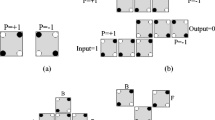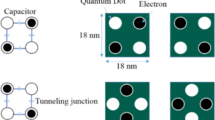Abstract
Quantum-dot cellular automata (QCA) is a new nanotechnology for the implementation of nano-sized digital circuits. This nanotechnology is remarkable in terms of speed, area, and power consumption compared to complementary metal-oxide-semiconductor (CMOS) technology and can significantly improve the design of various logic circuits. We propose a new method for implementing a T-latch in QCA technology in this paper. The proposed method uses the intrinsic features of QCA in timing and clock phases, and therefore, the proposed cell structure is less occupied and less power-consuming than existing implementation methods. In the proposed T-latch, compared to previous best designs, reductions of 6.45% in area occupation and 44.49% in power consumption were achieved. In addition, for the first time, a reset-based T-latch and a T-latch with set and reset capabilities are designed. Using the proposed T-latch, a new 3-bit counter is developed which reduces 2.14% cell numbers compared to the best of previous designs. Moreover, based on the 3-bit counter, a 4-bit counter is designed, which reduces 0.51% cell numbers and 4.16% cross-section area compared to previous designs. In addition, two selective counters are introduced to count from 0 to 5 and from 2 to 5. Simulations were performed using QCADesigner and QCAPro tools in coherence vector engine mode. The proposed circuits are compared with related designs in terms of delay, cell numbers, area, and leakage power.
摘要
量子点元胞自动机(QCA)是一种用于实现纳米数字电路的新型纳米技术。这种纳米技术在速度、面积和功耗方面都优于互补金属氧化物半导体(CMOS)技术, 并且可以显著改善各种逻辑电路设计。本文提出一种在QCA技术中实现T型锁存器的新方法, 该方法利用了QCA在时序和时钟相位上的固有特征, 因此, 所提单元结构与现有方法相比占用面积更少, 功耗更低。与之前的最佳设计相比, 该T型锁存器的占用面积减少6.45%, 功耗降低44.49%。此外, 本文首次设计了基于复位的T型锁存器和具有置位和复位功能的T型锁存器。基于所提T型锁存器, 开发了一种新型3位计数器, 与之前的最佳设计相比减少2.14%的单元数。在3位计数器的基础上, 设计了4位计数器, 与之前的设计相比, 减少0.51%的单元数和4.16%的截面积。此外还引入两个选择性计数器, 分别从0到5和从2到5进行计数。在相干矢量引擎模式下, 使用QCADesigner和QCAPro软件进行模拟, 并将所提电路与相关设计在延迟、单元数、面积和漏电功率方面进行了比较。
Similar content being viewed by others
Data availability
The data that support the findings of this study are available from the corresponding author upon reasonable request.
References
Abutaleb MM, 2018a. A novel configurable flip flop design using inherent capabilities of quantum-dot cellular automata. Microprocess Microsyst, 56:101–112. https://doi.org/10.1016/j.micpro.2017.11.003
Abutaleb MM, 2018b. Robust and efficient QCA cell-based nanostructures of elementary reversible logic gates. J Supercomput, 74(11):6258–6274. https://doi.org/10.1007/s11227-018-2550-z
Ahmadpour SS, Mosleh M, Heikalabad SR, 2022. Efficient designs of quantum-dot cellular automata multiplexer and RAM with physical proof along with power analysis. J Supercomput, 78(2): 1672–1695. https://doi.org/10.1007/s11227-021-03913-2
Akbari-Hasanjani R, Sabbaghi-Nadooshan R, 2022. Innovation quinary and n-value toward fuzzy logic QCA cell design. Adv Theory Simul, 5(2):2100304. https://doi.org/10.1002/adts.202100304
Akbari-Hasanjani R, Sabbaghi-Nadooshan R, Tanhayi MR, 2021. New polarization and power calculations with error elimination in ternary QCA. Comput Electr Eng, 96:107557. https://doi.org/10.1016/j.compeleceng.2021.107557
Akbari-Hasanjani R, Sabbaghi-Nadooshan R, Haghparast M, 2022. Toward quaternary QCA: novel majority and XOR fuzzy gates. IEEE Access, 10:38511–38522. https://doi.org/10.1109/ACCESS.2022.3165200
Amirzadeh Z, Gholami M, 2019. Counters designs with minimum number of cells and area in the quantum-dot cellular automata technology. Int J Theor Phys, 58(6):1758–1775. https://doi.org/10.1007/s10773-019-04070-2
Angizi S, Navi K, Sayedsalehi S, et al., 2014. Efficient quantum dot cellular automata memory architectures based on the new wiring approach. J Comput Theor Nanosci, 11(11):2318–2328. https://doi.org/10.1166/jctn.2014.3646
Angizi S, Moaiyeri MH, Farrokhi S, et al., 2015. Designing quantum-dot cellular automata counters with energy consumption analysis. Microprocess Microsyst, 39(7):512–520. https://doi.org/10.1016/j.micpro.2015.07.011
Bahar AN, Wahid KA, 2022. Design and implementation of an N×32-bit SRAM in QCA using coplanar wire-crossing network. Optik, 266:169577. https://doi.org/10.1016/j.ijleo.2022.169577
Bhavani KS, Alinvinisha V, 2015. Utilization of QCA based T flip flop to design counters. Proc Int Conf on Innovations in Information, Embedded and Communication Systems, p.1–6. https://doi.org/10.1109/ICIIECS.2015.7193059
Dehbozorgi L, Sabbaghi-Nadooshan R, Kashaninia A, 2022a. Novel fault-tolerant processing in memory cell in ternary quantum-dot cellular automata. J Electron Test, 38(4):419–444. https://doi.org/10.1007/s10836-022-06018-7
Dehbozorgi L, Sabbaghi-Nadooshan R, Kashaninia A, 2022b. Realization of processing-in-memory using binary and ternary quantum-dot cellular automata. J Supercomput, 78(5):6846–6874. https://doi.org/10.1007/s11227-021-04152-1
Dutta P, Mukhopadhyay D, 2014. New architecture for flip flops using quantum-dot cellular automata. ICT and Critical Infrastructure: Proc 48th Annual Convention of Computer Society of India-Vol II, p.707–714. https://doi.org/10.1007/978-3-319-03095-1_77
Fazili MM, Shah MF, Naz SF, et al., 2022. Next generation QCA technology based true random number generator for cryptographic applications. Microelectr J, 126:105502. https://doi.org/10.1016/j.mejo.2022.105502
Gholami M, Amirzadeh Z, 2023. Novel low-latency T-latch with minimum number of cells in QCA technology. Adv Theory Simul, 6(1):2200686. https://doi.org/10.1002/adts.202200686
Gholami M, Movahedi M, Amirzadeh Z, 2022. Latch and flip-flop design in QCA technology with minimum number of cells. Comput Electr Eng, 102:108186. https://doi.org/10.1016/j.compeleceng.2022.108186
Hashemi S, Navi K, 2012. New robust QCA D flip flop and memory structures. Microelectr J, 43(12):929–940. https://doi.org/10.1016/j.mejo.2012.10.007
Kalyan BS, Kaur H, Pachori K, et al., 2022. An efficient design of D flip flop in quantum-dot cellular automata (QCA) for sequential circuits. In: Nandan D, Mohanty BK, Kumar S, et al. (Eds.), VLSI Architecture for Signal, Speech, and Image Processing. Apple Academic Press, New York, USA, p.253–272.
Khan A, Arya R, 2022. Efficient design of dual-mode nano counter: an approach using quantum dot cellular automata. Concurr Comput Pract Exp, 34(13):e6910. https://doi.org/10.1002/cpe.6910
Kim K, Wu KJ, Karri R, 2005. Towards designing robust QCA architectures in the presence of sneak noise paths. Proc Design, Automation and Test in Europe, p.1214–1219. https://doi.org/10.1109/DATE.2005.316
Majeed AH, Alkaldy E, bin Zainal MS, et al., 2019. Synchronous counter design using novel level sensitive T-FF in QCA technology. J Low Power Electron Appl, 9(3):27. https://doi.org/10.3390/jlpea9030027
Nafees N, Ahmed S, Kakkar V, et al., 2022. QCA-based PIPO and SIPO shift registers using cost-optimized and energy-efficient D flip flop. Electronics, 11(19):3237. https://doi.org/10.3390/electronics11193237
Rad SK, Heikalabad SR, 2017. Reversible flip-flops in quantum-dot cellular automata. Int J Theor Phys, 56(9):2990–3004. https://doi.org/10.1007/s10773-017-3466-8
Sheikhfaal S, Angizi S, Sarmadi S, et al., 2015. Designing efficient QCA logical circuits with power dissipation analysis. Microelectr J, 46(6):462–471. https://doi.org/10.1016/j.mejo.2015.03.016
Torabi M, 2011. A new architecture for T flip flop using quantum-dot cellular automata. Proc 3rd Asia Symp on Quality Electronic Design, p.296–300. https://doi.org/10.1109/ASQED.2011.6111764
Torres FS, Wille R, Niemann P, et al., 2018. An energy-aware model for the logic synthesis of quantum-dot cellular automata. IEEE Trans Comput Aided Des Integr Circ Syst, 37(12): 3031–3041. https://doi.org/10.1109/TCAD.2018.2789782
Zoka S, Gholami M, 2018. A novel rising edge triggered resettable D flip-flop using five input majority gate. Microprocess Microsyst, 61:327–335. https://doi.org/10.1016/j.micpro.2018.06.006
Author information
Authors and Affiliations
Contributions
Mohammad GHOLAMI designed the research. Zaman AMIRZADEH processed the data and drafted the paper. Mohammad GHOLAMI revised and finalized the paper.
Corresponding author
Additional information
Compliance with ethics guidelines
Mohammad GHOLAMI and Zaman AMIRZADEH declare that they have no conflict of interest.
Project supported by the Iran National Science Foundation (No. 4005782)
Rights and permissions
About this article
Cite this article
Gholami, M., Amirzadeh, Z. Low-power, high-speed, and area-efficient sequential circuits by quantum-dot cellular automata: T-latch and counter study. Front Inform Technol Electron Eng 24, 457–469 (2023). https://doi.org/10.1631/FITEE.2200361
Received:
Accepted:
Published:
Issue Date:
DOI: https://doi.org/10.1631/FITEE.2200361
Key words
- Quantum-dot cellular automata (QCA)
- Quantum-dot
- T-latch
- T-flip-flop
- Counter
- Selective counter
- QCADesigner
- QCAPro




